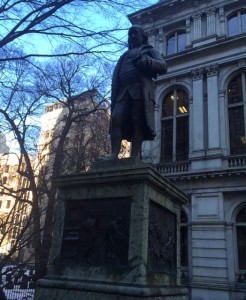“Beer is proof that God loves us and wants to see us happy.”
Many of us have probably seen this quoted at least one time in our life whether it be on a t-shirt, a mug, a poster, etc. with a picture of Benjamin Franklin above or below it. However, contrary to popular belief Benjamin Franklin did not in fact ever say these alleged words. This has created a common misconception about Franklin being a lover and avid consumer of beer.
This quote originally came from a letter that Franklin wrote to his friend Abbe Morellet where Franklin wrote: “We hear of the conversion of water into wine at the marriage in Cana, as of a miracle. But this conversion is, through the goodness of God, made every day before our eyes. Behold the rain which descends from heaven upon our vineyards, and which incorporates itself with the grapes to be changed into wine; a constant proof that God loves us, and loves to see us happy”. It has been difficult for historians to find when exactly Franklin began being misquoted and when the subject of the quote changed over to beer. Regardless, historians can confirm that the infamous quote from Franklin has been misinterpreted and changed from its original content.
Therefore, one can conclude that though Franklin may not have been as big a fan of beer that people have made him out to be; he apparently possessed a deep passion for wine and felt that it was a sheer sign that God wanted humans to be happy.

Source: http://freakonomics.com/2011/03/24/quotes-uncovered-beer-or-wine-as-proof/
http://beer.about.com/od/historyofbeer/f/Did-Benjamin-Franklin-Really-Say-Beer-Is-Proof-That-God-Loves-Us-And-Wants-Us-To-Be-Happy.htm
